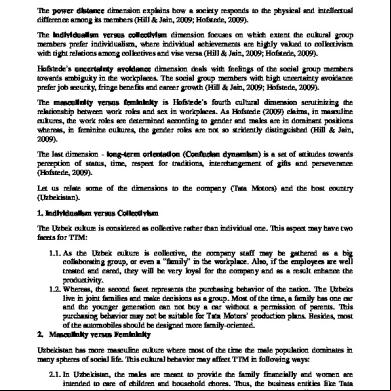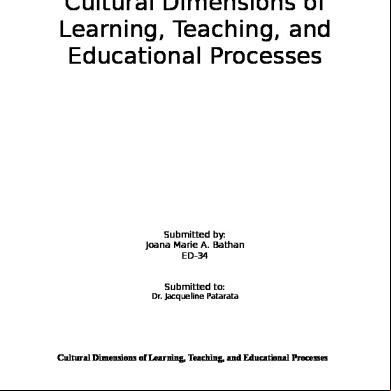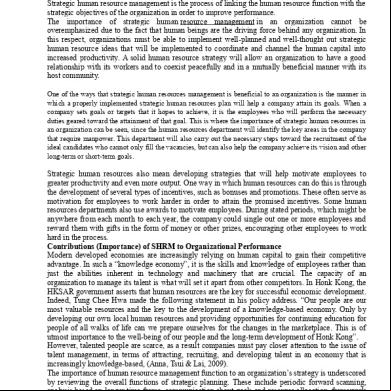Cultural Dimensions Globe Varsha Pandey 5n6l69
This document was ed by and they confirmed that they have the permission to share it. If you are author or own the copyright of this book, please report to us by using this report form. Report 3b7i
Overview 3e4r5l
& View Cultural Dimensions Globe Varsha Pandey as PDF for free.
More details w3441
- Words: 383
- Pages: 6
CULTURAL DIMENSIONS BYVARSHA PANDEY IMBA- 10th semester
GLOBE PROJECT • Research on the relationship between culture and leadership resulted in the GLOBE research program. GLOBE study is a major study with broad applicability. • GLOBE Project – Global Leadership and Organizational Behaviour Effectiveness- 9D cultural model • Findings emerge from a well developed research design-Used quantitative methods to study the responses of 17,000 managers in 950 organizations, 62 different cultures • Developed a classification of cultural dimensions – identified nine cultural dimensions • Model provides information on what is universally accepted as good and bad leadership. • Model underscores complexity of leadership process and how culture influences it.
GLOBE PROJECT Nine cultural dimensions• Assertiveness- tough confrontational and competitive • Future Orientation • Performance Orientation • Human Orientation • Gender differentiation • In group collectivism- pride, loyalty and cohesiveness in organizations and families • Collectivism- collective distribution of resources and collective action • Power Distance • Uncertainty avoidance
1. Assertiveness—Degree to which people in a culture are determined, assertive, confrontational, and aggressive in their social relationships 2. Future orientation—Degree to which individuals in a culture engage in planning, investing, and delaying gratification. 3. Performance orientation—Degree to which organization or society rewards group for improved performance and excellence 4. Humane orientation—degree to which a culture encourages and rewards people for being fair, altruistic, generous, caring, and kind to others. 5. Gender differentiation /egalitarianism—Degree to which organization or society minimizes gender role differences & promotes gender equality
6. In-group collectivism—The degree to which people express pride, loyalty, and cohesiveness in their organizations and families. 7. Institutional collectivism—The degree to which an organization or society encourages collective action, collective distribution of resources and collective action. 8. Power distance—The degree to which power is stratified or degree to which of a group expect and agree that power should be shared unequally 9. Uncertainty avoidance—Extent to which a society, organization, or group relies on established social norms, rituals, and procedures to avoid uncertainty. The use of rules, structures, and laws to make things more predictable.
APPLICATIONS • Help understand own cultural biases & preferences • Help understand what it means to be a good leader. • Help communication across cultural and geographic boundaries. • Model provides information on what is universally accepted as good and bad leadership.
GLOBE PROJECT • Research on the relationship between culture and leadership resulted in the GLOBE research program. GLOBE study is a major study with broad applicability. • GLOBE Project – Global Leadership and Organizational Behaviour Effectiveness- 9D cultural model • Findings emerge from a well developed research design-Used quantitative methods to study the responses of 17,000 managers in 950 organizations, 62 different cultures • Developed a classification of cultural dimensions – identified nine cultural dimensions • Model provides information on what is universally accepted as good and bad leadership. • Model underscores complexity of leadership process and how culture influences it.
GLOBE PROJECT Nine cultural dimensions• Assertiveness- tough confrontational and competitive • Future Orientation • Performance Orientation • Human Orientation • Gender differentiation • In group collectivism- pride, loyalty and cohesiveness in organizations and families • Collectivism- collective distribution of resources and collective action • Power Distance • Uncertainty avoidance
1. Assertiveness—Degree to which people in a culture are determined, assertive, confrontational, and aggressive in their social relationships 2. Future orientation—Degree to which individuals in a culture engage in planning, investing, and delaying gratification. 3. Performance orientation—Degree to which organization or society rewards group for improved performance and excellence 4. Humane orientation—degree to which a culture encourages and rewards people for being fair, altruistic, generous, caring, and kind to others. 5. Gender differentiation /egalitarianism—Degree to which organization or society minimizes gender role differences & promotes gender equality
6. In-group collectivism—The degree to which people express pride, loyalty, and cohesiveness in their organizations and families. 7. Institutional collectivism—The degree to which an organization or society encourages collective action, collective distribution of resources and collective action. 8. Power distance—The degree to which power is stratified or degree to which of a group expect and agree that power should be shared unequally 9. Uncertainty avoidance—Extent to which a society, organization, or group relies on established social norms, rituals, and procedures to avoid uncertainty. The use of rules, structures, and laws to make things more predictable.
APPLICATIONS • Help understand own cultural biases & preferences • Help understand what it means to be a good leader. • Help communication across cultural and geographic boundaries. • Model provides information on what is universally accepted as good and bad leadership.










